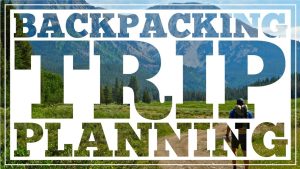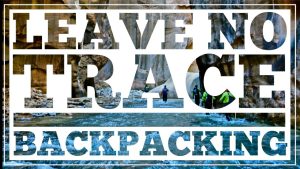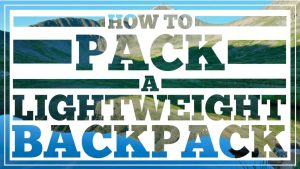Ep. 9 – Learn to Love Backpacking in the Rain
Some of the links on this page are affiliate links
Backpacking In Rain
Backpacking in the rain isn’t everyone’s idea of a fantastic time in the woods. It’s going to be wet, cold, and visibility will be greatly reduced. If you’re not properly prepared, backpacking in the rain can be all-out miserable. But if you’re ready for it, backpacking in the rain can actually be a lot of fun.
When conditions are wet you’ll be able to avoid the crowds, you’ll probably see more wildlife, and you’ll be able to experience wilderness areas in completely different way. Being good at backpacking in the rain is a skill that takes years of practice. The more time you spend doing it, the better you’ll get. It’s a good idea to practice close to home at first, so you can hone your skills before heading out on a more extreme trip.
Positive Mental Attitude
One of the most important factors to having a good time during a rainy backpacking trip is having a positive attitude. If you’re mentally prepared to be wet and still have fun, you’ll probably have a great time. You can sing, and dance to keep warm, or bring fun games to play in your tent.
One concept that’s tough for beginners to accept is that, if it rains for an extended period of time on your trip, you’re going to get wet, and there’s really no avoiding it. Waterproof gear will keep the water out, but it also forms a barrier that holds your body heat in, which leads to condensation and increased perspiration.
Even the most expensive and breathable rain gear won’t keep your body completely dry while you hike in extended rain. The same is true of waterproof shoes. Waterproof shoes don’t breath well and your feet will sweat while you hike.
When it rains, water from brush along the trail will run down your legs and into your shoes. Gaiters and rain pants can delay the effect, but eventually, your feet are going to be soaked one way or another.
Rather than trying to prevent getting wet, it’s better to just accept that you’re going to get wet and learn how to best adapt to it. With the right skills, you can still stay warm, hike comfortably, and have completely dry evenings, even during days of nonstop rain. Here are some tips that will help you to stay positive and continue to have fun on the trail, even during days of downpour.
Wet Weather Tips
First, always know the weather forecast for the area that you’re backpacking in. That will give you a good idea of what to expect on your trip. It can be tough to pinpoint the exact wilderness area that you will be hiking in, but you can get a good idea by looking at weather reports for small cities around the area.
Even after you know the weather forecast, be prepared for bad weather. Weather patterns are very tough to predict, especially around mountains and at high elevations. Always take rain gear and be prepared for showers. Being unprepared for a rainstorm can be uncomfortable and very dangerous. Without raingear you won’t be able to regulate your body temperature and hypothermia can quickly set in.
When it first starts to rain, or if it looks like it will rain, take five minutes to make sure your backpack is properly packed for showers. Don’t assume that your backpack is waterproof, even if it claims to be. Even light showers can penetrate your backpack through seams in the stitching.
One big beginner mistake is to continue hiking in light rain without checking to make sure your equipment is properly stored. If your gear gets wet, it could be days before you can dry it again.
The best way to ensure that your gear will stay dry in your backpack is by lining the inside of your backpack with a waterproof bag. Trash bags work great for this purpose. You can also use waterproof stuff sacks and plastic food storage bags.
You’ll want to make absolutely sure that you sleeping bag, headlamp, electronics, fire starters, first aid kit, maps, and extra clothes and stay dry. Consider bringing a waterproof map case because you’ll still need to use your map in the rain.
Over the years I’ve found that pack covers just don’t cut it in the rain. Pack covers don’t protect the back of your backpack. Water that lands on your jacket will run down your back and soak through the uncovered side of your pack, so it’s usually better to focus on protecting items on the inside of your pack.
Clothing, Jackets, & Footwear
For clothing, choose synthetic layers that will dry quickly and retain heat when they’re wet. Avoid all cotton and denim clothing, which will be heavy and cold.
Choose a lightweight rain shell with good ventilation that is breathable and test it before you take it on the trail. You don’t need an expensive jacket to protect against the rain, just something that will repel water and allow you to control your interior body temperature. Check out our favorite jackets here.
When you’re hiking in your raincoat, you can use your hood, pit zips, wrist straps, and the main zipper to regulate your body temperature. Leave them open to reduce overheating or close them up to keep warm.
Rain pants won’t ventilate your body heat as well, but they are good to have, especially on cold weather trips. I rarely wear my rain pants when hiking, unless it’s very cold outside. My hiking pants or shorts will dry quickly and it’s easy for me to keep warm if I keep moving.
For footwear, choose lightweight running shoes that won’t hold water in and will dry quickly. Your feet are going to get wet if it rains, even if you have waterproof shoes. Running shoes will still be comfortable, light, and keep your feet warm when it rains. The main difference is that running shoes will dry much quicker when the rain stops. 5 Reasons to Ditch Your Hiking Boots.
If your feet remain wet throughout the day, make sure they are clean and dry throughout the night. If it’s still wet in the morning, put your wet socks back on and save your dry socks for when the rain stops and your shoes are dry. You’ll be very happy you did later on.
A hat with a bill is good to have in the rain too. It will keep water off of your face and will provide warmth for your head, which will be your main source of heat loss in the rain.
Managing Body Temperature
Managing your body temperature is very important when hiking in the rain. It’s usually easy to stay warm if you keep moving, but you need to be careful not to sweat too much. Use clothing layers and ventilation to keep from overheating. Also, regulate your pace so you don’t sweat too much while you hike in the rain.
It’s also important to stay well hydrated and well fed when it’s raining. Hikers generally drink and eat a lot less when it rains. Your body needs fuel and water to stay warm and regulate your temperature, so force yourself to eat and drink regularly.
You’ll also probably take fewer breaks when it’s raining, because your body will quickly cool down when you stop walking. Take shorter breaks more often to keep your body from wearing down.
Know the symptoms of hypothermia and know how to treat it. If you or a hiking partner starts to show signs of hypothermia, stop immediately, pitch your shelter, and get dry and warm as quick as possible.
Smart Choices in Bad Weather
Pay attention to your surroundings in heavy rain and make smart choices. Flash flooding can occur in heavy rains and river crossings can become very dangerous. Heavy rains also increases erosion and can cause mudslides and rockslides. You’ll want to avoid hiking in slot canyons during heavy rain as well. Never camp in a dry riverbed. Rain could start during the night and your tent could quickly be in the middle of a flowing river.
When you setup your shelter after a day of rain, keep the inside of your shelter dry by leaving all of your wet items outside. Don’t bring your backpack, your raincoat, or even your wet clothes inside your shelter. That will help to separate your dry items from your wet ones and you’ll be able to keep items dry for much longer.
Test your shelter in the rain before you take it on the trail and set it up in an area with good water drainage. Waking up with standing water in your tent is a surprisingly common mistake and it’s completely avoidable.
Own Your Hike
If you think a rainstorm might be short and you have time to spare, you could always pitch your shelter during the day and wait it out. Also, don’t feel guilty about changing your plans if you have enough food and flexibility built into your itinerary. It’s your hike, so do what makes you happy.
Remember, having a positive attitude will make all the difference when it’s raining outside. And it’s always important to consider, even if you’re backpacking in the rain, you could be sitting in a cubicle somewhere doing work instead. And backpacking in the rain is surely better than that!
MORE EPISODES IN THIS SERIES
View all





